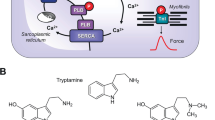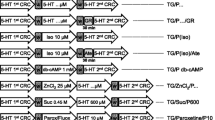Abstract
Serotonin (5-hydroxytryptamine, 5-HT) increases contractile force and elicits arrhythmias through 5-HT4 receptors in porcine and human atrium, but its ventricular effects are unknown. We now report functional 5-HT4 receptors in porcine and human ventricle. 5-HT4 mRNA levels were determined in porcine and human ventricles and contractility studied in ventricular trabeculae. Cyclic AMP-dependent protein kinase (PKA) activity was measured in porcine ventricle. Porcine and human ventricles expressed 5-HT4 receptor mRNA. Ventricular 5-HT4(b) mRNA was increased by four times in 20 failing human hearts compared with five donor hearts. 5-HT increased contractile force maximally by 16% (EC50=890 nM) and PKA activity by 20% of the effects of (−)-isoproterenol (200 μM) in ventricular trabeculae from new-born piglets in the presence of the phosphodiesterase-inhibitor 3-isobutyl-1-methylxanthine. In ventricular trabeculae from adult pigs (3-isobutyl-1-methylxanthine present) 5-HT increased force by 32% (EC50=60 nM) and PKA activity by 39% of (−)-isoproterenol. In right and left ventricular trabeculae from failing hearts, exposed to modified Krebs solution, 5-HT produced variable increases in contractile force in right ventricular trabeculae from 4 out of 6 hearts and in left ventricular trabeculae from 3 out of 3 hearts— range 1–39% of (−)-isoproterenol, average 8%. In 11 left ventricular trabeculae from the failing hearts of four β-blocker-treated patients, pre-exposed to a relaxant solution with 0.5 mM Ca2+ and 1.2 mM Mg2+ followed by a switch to 2.5 mM Ca2+ and 1 mM Mg2+, 5-HT (1–100 μM, 3-isobutyl-1-methylxanthine present) consistently increased contractile force and hastened relaxation by 46% and 25% of (−)-isoproterenol respectively. 5-HT caused arrhythmias in three trabeculae from 3 out of 11 patients. In the absence of phosphodiesterase inhibitor, 5-HT increased force in two trabeculae, but not in another six trabeculae from 4 patients. All 5-HT responses were blocked by 5-HT4 receptor antagonists. We conclude that phosphodiesterase inhibition uncovers functional ventricular 5-HT4 receptors, coupled to a PKA pathway, through which 5-HT enhances contractility, hastens relaxation and can potentially cause arrhythmias.








Similar content being viewed by others
References
Bach T, Syversveen T, Kvingedal AM, Krobert KA, Brattelid T, Kaumann AJ, Levy FO (2001) 5-HT4(a) and 5-HT4(b) receptors have nearly identical pharmacology and are both expressed in human atrium and ventricle. Naunyn-Schmiedebergs Arch Pharmacol 363:146–160
Bender E, Pindon A, von Oers I, Zhang YB, Gommeren W, Verhasselt P, Jurzak M, Leysen J, Luyten W (2000) Structure of the human serotonin 5-HT4 receptor gene and cloning of a novel 5-HT4 splice variant. J Neurochem 74:478–489
Blondel O, Gastineau M, Dahmoune Y, Langlois M, Fischmeister R (1998) Cloning, expression, and pharmacology of four human 5-hydroxytryptamine4 receptor isoforms produced by alternative splicing in the carboxyl terminus. J Neurochem 70:2252–2261
Bockaert J, Claeysen S, Compan V, Dumuis A (2004) 5-HT4 receptors. Curr Drug Target CNS Neurol Disord 3:39–51
Brattelid T, Kvingedal AM, Krobert KA, Andressen KW, Bach T, Hystad ME, Kaumann AJ, Levy FO (2004) Cloning, pharmacological characterisation and tissue distribution of a novel 5-HT4 receptor splice variant, 5-HT4(i). Naunyn-Schmiedebergs Arch Pharmacol 369:616–628
Bustin SA (2000) Absolute quantification of mRNA using real-time reverse transcription polymerase chain reaction assays. J Mol Endocrinol 25:169–193
Chandra M, Gupta V, Johri AK, Misra R, Kumar A, Gujrati V, Shanker K (1994) Serotonergic mechanisms in heart failure. Indian Heart J 46:153–156
England PJ (1976) Studies on the phosphorylation of the inhibitory subunit of troponin during modification of contraction in perfused rat heart. Biochem J 160:295–304
Garvey JL, Kranias EG, Solaro RJ (1988) Phosphorylation of C-protein, troponin I and phospholamban in isolated rabbit hearts. Biochem J 249:709–714
Gerald C, Adham N, Kao HT, Olsen MA, Laz TM, Schechter LE, Bard JA, Vaysse PJ, Hartig PR, Branchek TA, Weinshank RL (1995) The 5-HT4 receptor: molecular cloning and pharmacological characterization of two splice variants. EMBO J 14:2806–2815
Jahnel U, Rupp J, Ertl R, Nawrath H (1992) Positive inotropic responses to 5-HT in human atrial but not in ventricular heart muscle. Naunyn-Schmiedebergs Arch Pharmacol 346:482–485
Jahnel U, Nawrath H, Rupp J, Ochi R (1993) L-type calcium channel activity in human atrial myocytes as influenced by 5-HT. Naunyn-Schmiedebergs Arch Pharmacol 348:396–402
Kaumann AJ (1990) Piglet sinoatrial 5-HT receptors resemble human atrial 5-HT4-like receptors. Naunyn-Schmiedebergs Arch Pharmacol 342:619–622
Kaumann AJ (1993) Blockade of human atrial 5-HT4 receptors by GR113808. Br J Pharmacol 110:1172–1174
Kaumann AJ (1994) Do human atrial 5-HT4 receptors mediate arrhythmias? Trends Pharmacol Sci 15:451–455
Kaumann AJ (2000) Gs-protein coupled receptors in human heart. In: Kenakin T, Angus JA (eds) The pharmacology of functional, biochemical, and recombinant receptor systems. Handbook of experimental pharmacology. Springer, Berlin Heidelberg New York, pp 73-116
Kaumann AJ, Sanders L (1994) 5-Hydroxytryptamine causes rate-dependent arrhythmias through 5-HT4 receptors in human atrium: facilitation by chronic β-adrenoceptor blockade. Naunyn-Schmiedebergs Arch Pharmacol 349:331–337
Kaumann AJ, Sanders L, Brown AM, Murray KJ, Brown MJ (1990) A 5-hydroxytryptamine receptor in human atrium. Br J Pharmacol 100:879–885
Kaumann AJ, Sanders L, Brown AM, Murray KJ, Brown MJ (1991) A 5-HT4-like receptor in human right atrium. Naunyn-Schmiedebergs Arch Pharmacol 344:150–159
Kaumann AJ, Gaster LM, King FD, Brown AM (1994) Blockade of human atrial 5-HT4 receptors by SB207710, a selective and high affinity 5-HT4 receptor antagonist. Naunyn-Schmiedebergs Arch Pharmacol 349:546–548
Kaumann AJ, Lynham JA, Brown AM (1995) Labelling with [125I]-SB207710 of a small 5-HT4 receptor population in piglet right atrium: functional relevance. Br J Pharmacol 115:933–936
Kaumann AJ, Lynham JA, Brown AM (1996) Comparison of the densities of 5-HT4 receptors, β1-, and β2-adrenoceptors in human atrium: functional implications. Naunyn-Schmiedebergs Arch Pharmacol 353:592–595
Kaumann A, Bartel S, Molenaar P, Sanders L, Burrell K, Vetter D, Hempel P, Karczewski P, Krause E-G (1999) Activation of β2-adrenergic receptors hastens relaxation and mediates phosphorylation of phospholamban, troponin I, and C-protein in ventricular myocardium from patients with terminal heart failure. Circulation 99:65–72
Lorrain J, Grosset A, O’Connor E (1992) 5-HT4 receptors, present in piglet atria and sensitive to SDZ 205-557, are absent in papillary muscle. Eur J Pharmacol 229:105–108
Medhurst AD, Lezoualc’h F, Fischmeister R, Middlemiss DN, Sanger GJ (2001) Quantitative mRNA analysis of five C-terminal splice variants of the human 5-HT4 receptor in the central nervous system by TaqMan real time RT-PCR. Brain Res Mol Brain Res 90:125–134
Mialet J, Berque-Bestel I, Eftekhari P, Gastineau M, Giner M, Dahmoune Y, Donzeau-Gouge P, Hoebeke J, Langlois M, Sicsic S, Fischmeister R, Lezoualc’h F (2000) Isolation of the serotoninergic 5-HT4(e) receptor from human heart and comparative analysis of its pharmacological profile in C6-glial and CHO cell lines. Br J Pharmacol 129:771–781
Mittmann C, Munstermann U, Weil J, Böhm M, Herzig S, Nienaber C, Eschenhagen T (1998) Analysis of gene expression patterns in small amounts of human ventricular myocardium by a multiplex RNase protection assay. J Mol Med 76:133–140
Murray KJ, England PJ, Lynham JA, Mills D, Schmitz-Pfeiffer C, Reeves ML (1990) Use of synthetic dodecapeptide (malantide) to measure the cyclic AMP-dependent protein kinase activity ratio in a variety of tissues. Biochem J 267:703–708
Ouadid H, Seguin J, Dumuis A, Bockaert J, Nargeot J (1992) Serotonin increases calcium current in human atrial myocytes via the newly described 5-hydroxytryptamine4 receptors. Mol Pharmacol 41:346–351
Pau D, Workman A, Kane KA, Rankin AC (2003) Electrophysiological effects of 5-hydroxytryptamine on isolated human atrial myocytes, and the influence of chronic β-adrenoceptor blockade. Br J Pharmacol 140:1434–1441
Perry SV (1979) The regulation of contractile activity in muscle. Biochem Soc Trans 7:593–617
Pino R, Cerbai E, Calamai G, Alajmo F, Borgioli A, Braconi L, Cassai M, Montesi GF, Mugelli A (1998) Effect of 5-HT4 receptor stimulation on the pacemaker current If in human isolated atrial myocytes. Cardiovasc Res 40:516–522
Rahme MM, Cotter B, Leistad E, Wadhwa MK, Mohabir R, Ford APDW, Eglen RM, Feld GK (1999) Electrophysiological and antiarrhythmic effects of the atrial selective 5-HT4 receptor antagonist RS-100302 in experimental atrial flutter and fibrillation. Circulation 100:2010–2017
Sanders L, Kaumann AJ (1992) A 5-HT4-like receptor in human left atrium. Naunyn-Schmiedebergs Arch Pharmacol 345:382–386
Sanders L, Lynham JA, Bond B, delMonte F, Harding SE, Kaumann AJ (1995) Sensitization of human atrial 5-HT4 receptors by chronic β blocker treatment. Circulation 92:2526–2639
Schoemaker RG, Du XY, Bax WA, Saxena RP (1992) 5-Hydroxytryptamine increases contractile force in porcine right atrium but not in left ventricle. Naunyn-Schmiedebergs Arch Pharmacol 346:486–489
Schoemaker RG, Du XY, Bax WA, Bos E, Saxena PR (1993) 5-Hydroxytryptamine stimulates human isolated atrium but not ventricle. Eur J Pharmacol 230:103–105
Shah AM, Andries LJ, Meulemans AL, Brutsaert DL (1989) Endocardium modulates myocardial inotropic responses to 5-hydroxytryptamine. Am J Physiol 257:H1790–H1797
Skomedal T, Borthne K, Aass H, Geiran O, Osnes J-B (1997) Comparison between alpha-1 adrenoceptor-mediated and beta adrenoceptor-mediated inotropic components elicited by norepinephrine in failing human ventricular muscle. J Pharmacol Exp Ther 280:721–729
Sole MJ, Shum A, VanLoon GR (1979) Serotonin: metabolism in the normal and failing heart. Circ Res 45:629–634
Ullmer C, Schmuck K, Kalkman HO, Lübbert H (1995) Expression of serotonin receptor mRNA in blood vessels. FEBS Lett 370:215–221
Vilaro MT, Domenech T, Palacios JM, Mengod G (2002) Cloning and characterization of a novel human 5-HT4 receptor variant that lacks the alternatively spliced carboxy terminal exon. RT-PCR distribution in human brain and periphery of multiple 5-HT4 receptor variants. Neuropharmacology 42:60–73
Vizir VA, Berezin AE (2001) Relationship between myocardial remodelling and neurohumoral activation in patients with cardiac failure. Klin Med (Mosk) 79:21–27
Acknowledgements
We are grateful to the British Heart Foundation, The Norwegian Council on Cardiovascular Diseases, The Research Council of Norway, Anders Jahre’s Foundation for the Promotion of Science and The Novo Nordisk Foundation for support.
Author information
Authors and Affiliations
Corresponding author
Additional information
The first two authors contributed equally to the present work
Rights and permissions
About this article
Cite this article
Brattelid, T., Qvigstad, E., Lynham, J.A. et al. Functional serotonin 5-HT4 receptors in porcine and human ventricular myocardium with increased 5-HT4 mRNA in heart failure. Naunyn-Schmiedeberg's Arch Pharmacol 370, 157–166 (2004). https://doi.org/10.1007/s00210-004-0963-0
Received:
Accepted:
Published:
Issue Date:
DOI: https://doi.org/10.1007/s00210-004-0963-0




